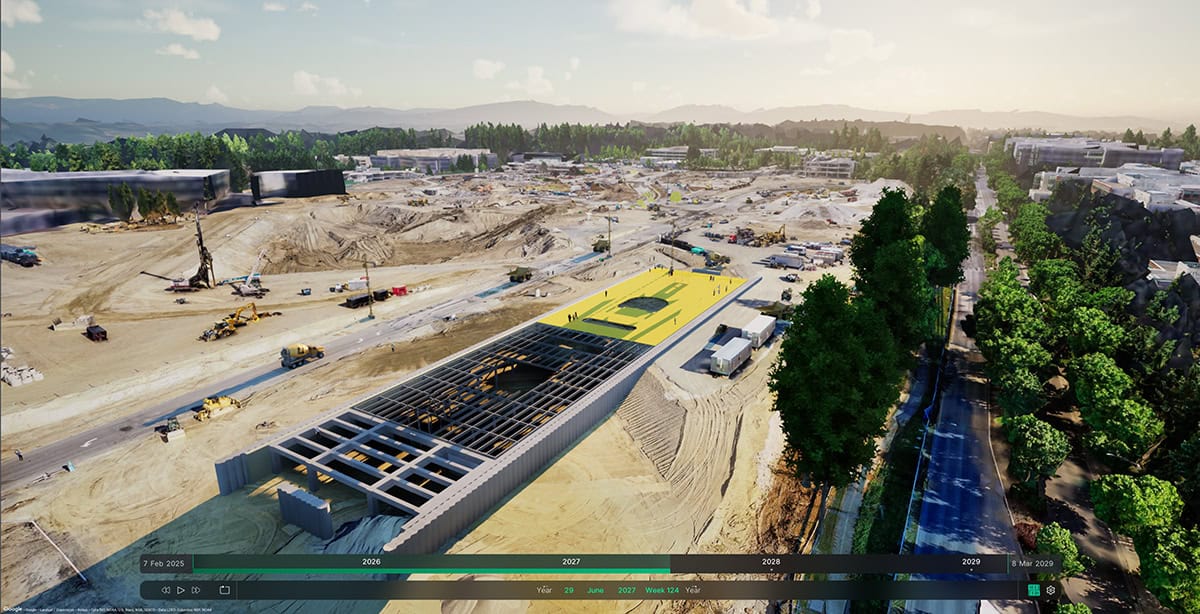Imagine walking across a bridge before a single beam has been laid—watching the sun reflect off the bridge’s steel, leaning over the railing to take in the river below.
With iTwin Engage, it’s possible.
Bentley Systems is debuting the new product this week in Amsterdam during the Year in Infrastructure and Going Digital Awards (YII) conference. By using iTwin Engage, projects like bridges, tunnels, and power plants aren’t just drawings on paper or models on a screen—they’re full, real-time immersive experiences. The point isn’t spectacle; it’s communication. iTwin Engage is giving teams and stakeholders a way to see, share, and make decisions with the clarity of standing inside the future they’re building. Visitors will be able to experience iTwin Engage inside Bentley’s popular iLab immersive experience space in Amsterdam.
For engineers and architects who live inside CAD files, visualization has long been a necessity. For everyone else, from contractors to community stakeholders, getting an accurate and up-to-date model of a new project destined for their community has often been out of reach. iTwin Engage is designed to solve that problem, making digital twins accessible in real time, on demand, and without the painstaking model optimization that could add days to the schedule.
“The main hurdle for our users is how to easily, seamlessly visualize a digital twin project,” says Nimrod Friedmann, a senior product manager at Bentley who leads the infrastructure engineering software company’s advanced visualization solution team. “By the time you finish optimizing a model, you’ve already had to make more changes. Our goal was to make this simple, seamless, and immediate.”
From Cesium tiles to Unreal pixels
The breakthrough behind iTwin Engage lies in the combination of engineering data from Bentley’s cloud-based iTwin platform with 3D Tiles, which is for streaming massive datasets, and Unreal Engine, for rendering cinematic-quality visuals. Unreal Engine powers many popular video games like Fortnite and Ark: Survival Ascended. 3D Tiles is an open standard developed by Cesium, the 3D geospatial company. Bentley acquired Cesium last year and its founder, Patrick Cozzi, now serves as Bentley’s chief platform officer.
“Cesium tiles let us stream the data quickly, and Unreal Engine pushes the pixels,” Friedmann explains. “That means you don’t sit around for half an hour waiting for a model to load. It just works. You can explore, enhance, and present in real time.”
Explore. Enhance. Present. That’s the philosophical backbone of iTwin Engage. Teams can instantly explore project data streamed as tiles, enhance scenes with context like lighting, vegetation, or traffic, and present them as narrative-driven experiences. “This isn’t just about raw data. It’s about telling the story of a project in a way people can consume and believe,” Friedmann says.
Friedmann says the integration of Cesium, iTwin, and open standards, along with application programming interfaces (APIs), also brings artificial intelligence (AI) into the picture.
Open-door policy
One of the revolutionary aspects of iTwin Engage is that it invites non-engineers into the process. It democratizes access.
“We see two roles,” Friedmann says. “You’ll have administrators or curators who build and shape the scenes, creating the narrative. Then you’ll have consumers or viewers who don’t need to curate or understand every project phase—they just want to experience it. A software user but also a city official, a community board, even the public can step into a curated presentation and see what’s coming, in a real-time immersive environment.”
For project teams, that inclusivity is transformative. Decisions no longer rest on static slides or technical files. Instead, they can be shaped by shared experiences, accessible to anyone with a browser.
Simplicity as strategy
This simplicity is not an accident; it’s the product ethos. “Our approach is: Let Bentley handle the complexity under the hood so the user doesn’t have to,” Friedmann says. “Users don’t need to export, reformat, or switch between different applications. You create your iTwin once, and from there you can access it across design, analysis, or advanced visualization. It’s all one source of truth.”
The integration with Bentley Infrastructure Cloud further reinforces that seamlessness. By linking iTwin Engage with the larger Bentley software ecosystem—MicroStation, OpenRoads, or Synchro—teams no longer juggle incompatible tools. “Traditionally, users have to move from software to software because they can’t get what they need in one place,” Friedmann says. “With Engage, they can leverage services from across the cloud while still working with the same project data.”
AI as a Workflow Partner
While iTwin Engage is not specifically an AI product, Friedmann sees AI as central to its future. “AI for us is about simplifying user workflows, not just adding flashy features,” he says.
He points to mundane but time-consuming tasks like populating vegetation across a project site. “Imagine a user defines a region and says, ‘I want to see oaks in the middle of winter in this geography,’” Friedmann explains. “Copilot can then do that automatically. You don’t need to manually place every tree. What used to take a day today can be done in 30 minutes. That means users can spend more focus on construction planning or design.”
Early Access, Early Wins
iTwin Engage has been in early access since March, and the feedback has been remarkably consistent. “What resonates most with users is the simplicity,” Friedmann says. “This isn’t about 100 features. Every feature we’ve added solves a real problem. And people notice that.”
Numerous beta testers have reported dramatic cuts to their visualization prep time. “That’s the value,” Friedmann says. “It’s not just visual immersiveness—it’s giving people their time back during their workday.”
The Bigger Picture
For Friedmann, iTwin Engage represents more than a product launch. It’s a philosophy. “In a big infrastructure project, visualization is often treated as a secondary concern,” he says. “But if you can’t communicate a project effectively, you can’t build consensus, you can’t secure funding, you can’t move forward. Engage makes communication simple and accessible.”
He adds: “At the end of the day, this is about solving critical user challenges. Taking away friction. Making something that used to be difficult and making it seamless. That’s what Engage is built to do.”
Thomas Kohnstamm is a journalist and author. His latest novel, Supersonic, came out in February, and Publisher’s Weekly named it of the most anticipated literary fiction titles for Spring 2025.









